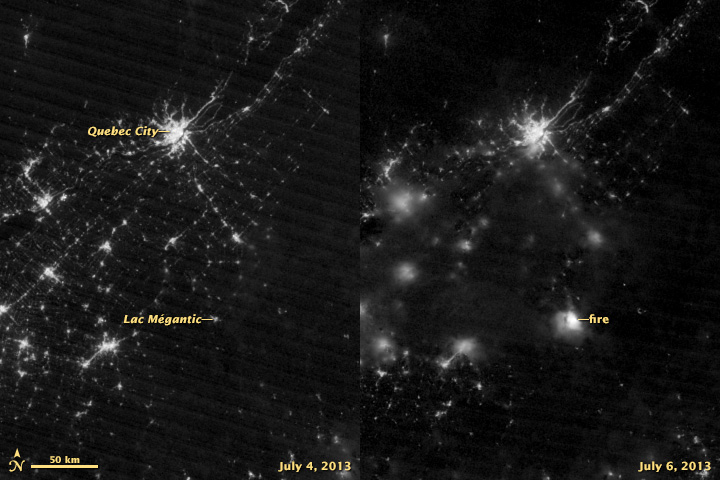Lac-Mégantic, Quebec was incorporated as a town in 1907, population 5,747 (2021 census), 5,654 (2016 census). Located in Estrie in the Regional County Municipality of Le Granit, the town of Lac-Mégantic is situated approximately 95 km east of Sherbrooke on the northeast shore of Lac Mégantic (see Eastern Townships). The town is Le Granit’s centre of industry (lumber and granite), administration and commerce. On 6 July 2013, a devastating train derailment occurred in Lac-Mégantic (see Lac-Mégantic Rail Disaster; Railway Disasters).
Settlement
The source of the Chaudière River is Lac Mégantic, which takes its name from an Abenaki word namesokanjik, meaning “place where fish are held” (see Indigenous Languages in Canada). The river was once a transportation route for the Abenaki people.
In the mid-19th century, people of French Canadian and Scottish origin began to settle in the region. The growth of the village of Mégantic would be closely tied to the development of the railway. For example, nearby Sainte-Agnès Parish was named after Susan Agnes Bernard, wife of John A. Macdonald, because the couple visited the area to promote railway development. The railway was inaugurated in 1878 and was integrated into the Canadian Pacific Railway network in 1894.
In 1907, the villages of Mégantic and Saint-Agnès merged to form the town of Mégantic. To emphasize its proximity to Lac Mégantic, the town was officially renamed Lac-Mégantic in 1958.
Economy
As the railway grew, Lac-Mégantic developed its logging, lumber, pulp and paper industries (see Forest Harvesting; Lumber and Wood Industries). Tourism has also become an important aspect of the town’s economy. The town houses the large Baie-des-Sables recreational tourist complex and is located in close proximity to two national parks, Frontenac National Park and Mont-Mégantic National Park.
Lac-Mégantic Rail Disaster
On 6 July 2013, a rail disaster occurred in Lac-Mégantic, killing 47 people and destroying a large section of the town’s downtown (see Lac-Mégantic Rail Disaster). On 5 July, at around 11:30 p.m., firefighters from the municipality of Nantes, Quebec were called to put out a fire that broke out inside a train locomotive belonging to the Montreal, Maine and Atlantic Railway company. While fighting the fire, the firefighters shut off the engine, thereby deactivating the air brake system. Because there were not enough hand brakes and there was a steep 1.2 per cent gradient from Nantes to Lac-Mégantic, 72 tank cars carrying light crude oil rolled downhill. With no conductor on board the train derailed in downtown Lac-Mégantic. The train derailment caused a series of explosions and a massive blaze that was visible from space. It was the fourth deadliest railway disaster in Canadian history (see Railway Disasters).

A Transportation Safety Board of Canada inquiry revealed that a broken piston likely caused the locomotive fire and that the tank cars the railway company used were not suitable for transporting the type of oil concerned. In addition to the human tragedy, more than 100,000 litres of crude oil were spilled into Lac Mégantic and the Chaudière River.
On 11 May 2018, after appeals from residents, the federal and provincial governments announced that the train’s rails would be re-routed from the town’s downtown core. The reconstruction of Lac-Mégantic’s infrastructure is ongoing.
Culture
The town is an industrial, commercial and tourism hub that provides services to the surrounding region. Lac-Mégantic is also home to a nature and astronomy interpretive centre (ASTROLab) and the Mont Mégantic Observatory, an astronomical observatory. This observatory is used by the Université de Montréal and the Université Laval and is equipped with a 1.6 m telescope.

 Share on Facebook
Share on Facebook Share on X
Share on X Share by Email
Share by Email Share on Google Classroom
Share on Google Classroom




